5 key facts about this project
Nature Weaving is an architectural design located in Milan, Italy, aimed at reconnecting the city’s urban environment with its natural waterways. In response to urban growth that has decreased green spaces and covered riverways with concrete, the project focuses on enhancing accessibility and ecological sustainability. The design promotes a cohesive network of parks and paths that allow residents to engage with nature in the city.
Design Concept and Structure
The main idea of Nature Weaving is to use waterways as a central feature for urban connectivity. Pathways are designed to align with the canal, improving access to green areas throughout the city. Adjacent road systems are divided into three functional zones: Attraction Areas for gatherings, Recreation Areas for various activities, and Restoration Areas that blend existing paths with new greenery. This structure facilitates diverse interactions between urban life and nature.
Pathway Types and User Interaction
Pathways play an important role in the design, featuring distinct types that encourage different types of engagement. Water Paths allow direct interaction with the canal. Filtering Plants Paths incorporate vegetation that helps with natural filtration. Pavilion Paths serve as communal spaces for gatherings, while Observation Paths provide viewpoints of the surrounding landscape. Each path type aims to enhance user experience and encourage positive connections with the environment.
Elevation and Circulation Strategies
The design takes into account elevation differences in the landscape. Natural steps are proposed to create transitions from pedestrian areas to the waterway levels. This approach enhances circulation and strengthens the connection between people and nature. By facilitating easy movement throughout the park, both pedestrians and cyclists can interact with the area while enjoying the integration of green spaces.
Ecological Integration and Community Engagement
Nature Weaving highlights the importance of sustainability through wetland integration. It promotes programming focused on nature, allowing residents to participate in activities like urban farming and gardening. This fosters community involvement and provides educational opportunities. The design enhances ecological viability and encourages a sense of ownership among residents, connecting them to their environment.
Through careful attention to the topography and pathways, Nature Weaving creates a network that promotes interaction and exploration. The arrangement of paths, viewpoints, and green areas provides a rich experience, showing how the city can coexist with its natural surroundings. Walking along these paths offers not just a route but a journey through a revitalized urban landscape that embraces nature.






















































